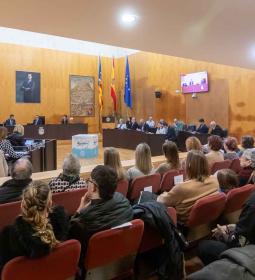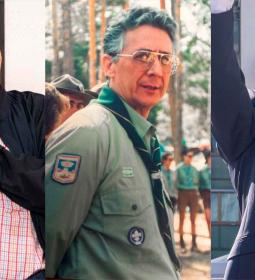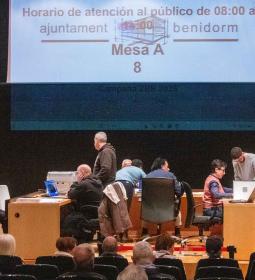Inaugurated the exhibition 'Almadrabas y sus capitanes' in Boca del Calvari Museum

Boca del Calvari Museum hosts from today until May 28 the exhibition 'Almadrabas y sus capitanes', which brings together a complete historical reconstruction of the almadrabas, their socioeconomic importance and the role of tuna fishers in La Marina Baixa, especially the sons of Benidorm.
The mayor of Benidorm, Toni Pérez; the first deputy mayor and councillor of Culture and Historic Heritage, Ana Pellicer; the senator Agustín Almodóbar; as well as numerous councilors and representatives of numerous social and cultural groups have attended the inauguration of the exhibition, which officially opened its doors at eight in the afternoon today.
Organized by the Department of Historic Heritage and Culture, it counts as a curator of the Exhibition with the writer and journalist Ángeles Ruiz, author of the publication 'De atún, almadrabas y sus capitanes', who has done extensive research on almadrabas and a work consisting of interviews and localization of written and graphic documents. The exhibition was done with a didactic communication scheme.
The mayor of Benidorm, Toni Pérez, said in the presentation that during generations "people from Benidorm had the trap in their veins," in allusion to the captains of our city's trap that were carried by dozens of sailors from Benidorm in their boats. Toni Pérez has stressed that "those people from Benidorm saw the world when it was very difficult to see the world, and from everything they saw there is much in Benidorm that we know today and that has become a world tour leader." The first mayor has recognized that "we have the obligation to look back and recognize the importance and significance of this part of our history."
The curator of the exhibition, Ángeles Ruiz, has debuted the content of the exhibition and has had words of gratitude "for all those who have helped me to collect such valuable material for the history of the trap in Benidorm." For his part, the photographer who has contributed the graphic documentation, Jaume Fuster, has wanted to put in value images that are part of a story that goes beyond the Mediterranean and where Benidorm was the protagonist.
This exhibition reveals how the captains of the traps of Benidorm, were solicited for their expertise and knowledge in this complex fishing gear and following the traces of the schools of tuna captained the majority of those located in the Mediterranean, the Eastern Atlantic , Morocco and Tunisia, also having presence in Algiers and Sicily. The mastery of the technicians of Benidorm does not stop growing and evidenced from the XVIII century until well into the XX century. The sons of Benidorm and La Vila Joiosa not only served as captains or made different trades in the fishing of trap, were also prominent shipowners, administrators and shareholders of the traps.
Thematic sections
The exhibition is structured in thematic sections. The groundfloor, immerses the visitor in the secret life of bluefin tuna, a sea colossus that crosses the waters every season, traveling thousands of miles, from the North Atlantic to the Mediterranean, over and over again, throughout its life to spawn in the place where it was born. Along the history; Phoenicians, Carthaginians, Greeks and Romans have appreciated its fine meat, rich in protein and suitable for salting.
On the ground floor you can see the particular microcosm of the trap, a city built between the waves with buoys, cables and anchors. The visitor will take a historical tour, from antiquity to the present day; From the minting of coins with the tuna as a symbol, to the famous Garum sauces that seduced the Roman palates.
On the first floor it is revealed as it was the technicians of Benidorm who directed the majority of the trappings, reaching to establish itself in the municipality authentic sagas of captains. But the commanders did not travel alone, they were accompanied by a number of experienced seamen from the area. Already in 1795, the eight trapped caldrons from Tortosa to Cartagena were in charge of captains of Benidorm and had 150 enrolled of this locality. The second floor includes images of a report made by photographer Jaume Fuster in a work guided by Captain Jacinto Vaello.
The exhibition "Almadrabas y sus capitanes" takes us back to the almadrabas in Dènia, Xàbia, Calpe, Moraira, La Vila Joiosa, Benidorm and Tabarca. Today the these traps belong to the past. Their disappearance was caused by a decrease in catches, an increase in the costs of materials and labor, and modern fishing technology.




